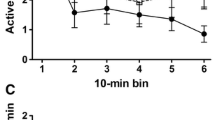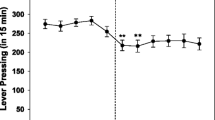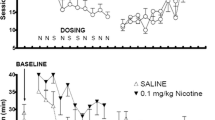Abstract
The hypothesis that dopamine (DA) receptor agonists and antagonists affect “hedonia” associated with natural rewards was tested, using a psychophysical procedure previously shown to be sensitive to both the sweetness of food and the motivational state of rats. Rats were first trained to discriminate between two different quantities of a rewarding stimulus by pressing one of two levers. Perceived quantity was subsequently derived from generalization trials of intermediate quantities. Haloperidol (0.03–0.083 mg/kg), a DA receptor antagonist, did not influence perceived food quantity, an indirect marker of hedonic value. On the other hand, d-amphetamine (0.25–1.0 mg/kg) affected perceived food quantity in a dose-dependent fashion, and in the same direction as occurs after increasing hunger or food sweetness. Both haloperidol and amphetamine influenced the perceived quantity of a stimulus without natural reinforcing properties (a tone), but the effect of amphetamine on the perceived quantity of this initially neutral stimulus was opposite in direction to that observed with food. These results suggest that whereas amphetamine affects hedonic processes, haloperidol does not. In addition, it seems that haloperidol probably produces its actions through effects on motor mechanisms or by interfering with the response-facilitating properties of rewards.
Similar content being viewed by others
References
Beninger RJ (1982) A comparison of the effects of pimozide and non-reinforcement on discriminated operant responding in rats. Pharmacol Biochem Behav 16:667–669
Church RM, Meck WH (1984) The numerical attribute of stimuli. In: Roitblat HL, Bever TG, Terrace HS (eds) Animal cognition. Lawrence Erlbaum Associates, New Jersey, pp 445–464
Clody DE, Carlton PL (1980) Stimulus efficacy, chlorpromazine and schizophrenia. Psychopharmacology 69:127–131
Dews PB, Morse WH (1961) Behavioral Pharmacology. Annu Rev Pharmacol 1:145–174
Ettenberg A, Koob GF, Bloom FE (1981) Response artifact in the measurement of neuroleptic-induced anhedonia. Science 209:357–359
Evenden JL, Robbins TW (1983) Dissociable effects of d-amphetamine, chlordiazepoxide and alpha-flupenthixol on choice and rate measures of reinforcement in the rat. Psychopharmacology 79:180–196
Faustman WO, Fowler SC (1981) Use of response duration to distinguish the effects of haloperidol from nonreward. Pharmacol Biochem Behav 15:327–329
Fibiger HC, Zis AP, Phillips AG (1975) Haloperidol induced disruption of conditioned avoidance responding: attenuation by prior training or by anticholinergic drugs. Eur J Pharmacol 30:309–314
Fouriezos G, Wise RA (1976) Pimozide-induced extinction of intracranial self-stimulation: response patterns rule out motor or performance deficits. Brain Res 103:377–380
Franklin KBJ (1978) Catecholamines and self-stimulation: reward and performance deficits dissociated. Pharmacol Biochem Behav 9:813–820
Franklin KBJ, McCoy SN (1979) Pimozide-induced extinction in rats: stimulus control of responding rules out motor deficit. Pharmacol Biochem Behav 11:71–75
Gallistel CR, Karras D (1984) Pimozide and d-amphetamine have opposing effects on the reward summation function. Pharmacol Biochem Behav 20:73–77
Gramling SE, Fowler SC, Collins KR (1984) Some effects of pimozide on nondeprived rats licking sucrose solutions in an anhedonia paradigm. Pharmacol Biochem Behav 21:617–624
Gray T, Wise RA (1980) Effects of pimozide on lever-pressing behavior maintained on an intermittent reinforcement schedule. Pharmacol Biochem Behav 12:931–935
Greenshaw AJ, Sanger DJ, Blackman DE (1981) The effects of pimozide and of reward omission on fixed-interval behavior of rats maintained by food and electrical brain stimulation. Pharmacol Biochem Behav 15:227–233
Heyman GM (1983) A parametric evaluation of the hedonic and motoric effects of drugs: pimozide and d-amphetamine. J Exp Anal Behav 40:113–122
Heyman GM, Kinzie DL, Seiden LS (1986) Chlorpromazine and pimozide alter reinforcement efficacy and motor performance. Psychopharmacology 88:346–353
Hill RT (1970) Facilitation of conditioned reinforcement as a mechanism of psychomotor stimulation. In: Costa E, Garattini S (eds) Amphetamines and related compounds. Raven, New York, pp 781–795
Irwin J, Tombaugh TN, Zacharko RM, Anisman H (1983) Alteration of exploration and the response to food associated cues after treatment with pimozide. Pharmacol Biochem Behav 18:235–246
Maricq AV, Church RW (1983) The differential effects of haloperidol and methamphetamine of time estimation in the rat. Psychopharmacology 79:10–15
Maricq AV, Roberts S, Church RW (1981) Methamphetamine and time estimation. J Exp Psychol: Anim Behav Process 7:18–30
Martin-Iverson MT, Fibiger HC, Wilkie, DM (1987) Alteration in the perception of food quantity by rats induced by manipulations of hunger and food sweetness. Learn Motiv
Mason ST, Beninger RJ, Fibiger HC, Phillips AG (1980) Pimozide-induced suppression of responding: evidence against a block of food reward. Pharmacol Biochem Behav 12:917–923
McCall RB, Appelbaum MI (1973) Bias in the analysis of repeated-measures designs: some alternative approaches. Child Dev 44:401–415
Morley MJ, Bradshaw CM, Szabadi E (1984) The effect of pimozide on variable-interval performance: a test of the “anhedonia” hypothesis of the mode of action of neuroleptics. Psychopharmacology 84:531–536
Morley MJ, Bradshaw CM, Szabadi E (1985) The effect of d-amphetamine on operant behaviour maintained under variable-interval schedules of reinforcement. Psychopharmacology 87:207–211
Phillips AG, Fibiger HC (1979) Decreased resistance to extinction after haloperidol: implications for the role of dopamine in reinforcement. Pharmacol Biochem Behav 10:751–760
Robbins TW (1975) The potentiation of conditioned reinforcement by psychomotor stimulant drugs: a test of Hill's hypothesis. Psychopharmacology 45:103–114
Robbins TW, Watson BA, Gaskin M, Ennis C (1983) Contrasting interactions of pipradol, d-amphetamine, cocaine, cocaine analogues, apomorphine and other drugs with conditioned reinforcement. Psychopharmacology 80:113–119
Salamone JD (1986) Differential effects of haloperidol and extinction on instrumental behaviours. Psychopharmacology 88:18–23
Spetch ML, Treit D (1984) The effect of d-amphetamine on short-term memory for time in pigeons. Pharmacol Biochem Behav 21:663–666
Stellar JR, Kelly AE, Corbett D (1983) Effects of peripheral and central dopamine blockade on lateral hypothalamic self-stimulation: evidence for both reward and motor deficits. Pharmacol Biochem Behav 18:433–442
Szostak C, Tombaugh TN, Tombaugh J (1981) Examination of the effects of pimozide on two conditional discrimination problems differing in levels of task complexity. Prog Neuropsychopharmacol 5:615–618
Taylor JR, Robbins TW (1984) Enhanced behavioural control by conditioned reinforcers following microinjections of d-amphetamine into the nucleus accumbens. Psychopharmacology 84:405–412
Tombaugh TN (1981) Effects of pimozide on nondiscriminated and discriminated performance in the pigeon. Psychopharmacology 73:137–141
Tombaugh TN, Ritch MA, Shepherd DT (1980) Effects of pimozide on accuracy of performance and distribution of correct responding on a simultaneous discrimination task in the rat. Pharmacol Biochem Behav 13:859–862
Tombaugh TN, Szostak C, Mills P (1983) Failure of pimozide to disrupt the acquisition of light-dark and spatial discrimination problems. Psychopharmacology 79:161–168
Wise RA (1982) Neuroleptics and operant behavior: the anhedonia hypothesis. Behav Brain Sci 5:39–87
Wise RA, Spindler J, DeWit H, Gerber GJ (1978) Neuroleptic-induced “anhedonia” in rats: pimozide blocks reward quality of food. Science 201:262–264
Author information
Authors and Affiliations
Rights and permissions
About this article
Cite this article
Martin-Iverson, M.T., Wilkie, D. & Fibiger, H.C. Effects of haloperidol and d-amphetamine on perceived quantity of foods and tones. Psychopharmacology 93, 374–381 (1987). https://doi.org/10.1007/BF00187260
Received:
Revised:
Issue Date:
DOI: https://doi.org/10.1007/BF00187260




